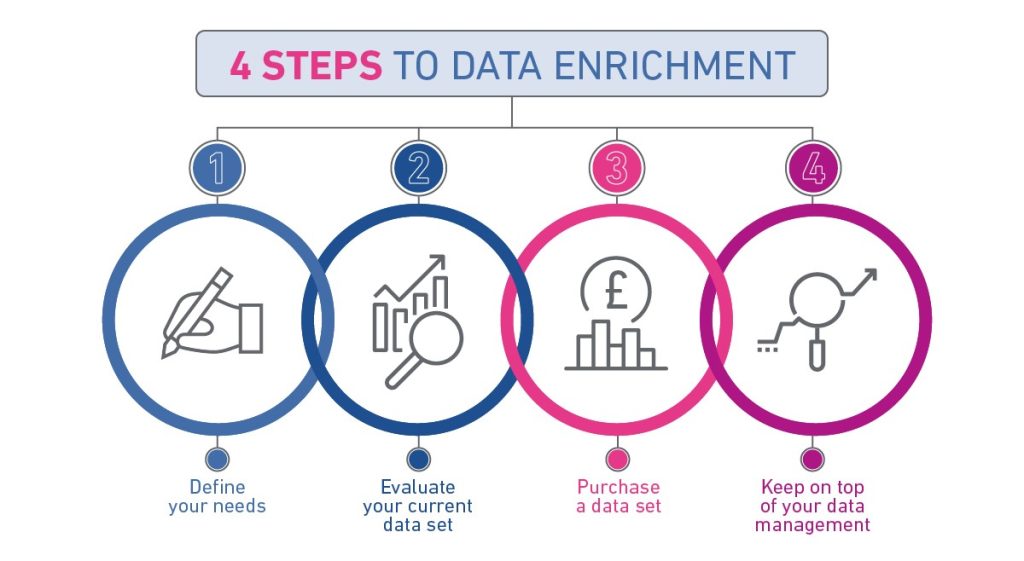What is Data Enrichment and why is it important?Helping you to make more accurate and informed business decisions
Guide
The more you know about your customers, the better business decisions you can make. More knowledge about their preferences and needs allows you to understand and predict consumer behaviour, spot future trends, and drive more conversions.
The advantages are clear but without proper management and processes to be sure the data is complete, up-to-date and reliable, you can often lose sight of the benefits.
This is where data enrichment comes in. To help you better understand what data enrichment is and how it can help you to make accurate data-based business decisions, we’ve put together this guide.
What is data enrichment?
Data enrichment is the process of enhancing the value of existing data with additional information. Enrichment often uses reliable third-party data sources to add more information to customer contact information or other data. The goal of data enrichment is to improve the value of the data by providing you with more insight into your customers.
What is data enrichment?
Data enrichment is the process of enhancing the value of existing data with additional information. Enrichment often uses reliable third-party data sources to add more information to customer contact information or other data.
No doubt you’ll have lots of customer data already. Information on their previous transactions or whether they’re signed up to your newsletter, for example. However, it’s also likely that you’re missing important data that adds up to create a complete and rich profile about them, their preferences, behaviours, and needs. Data enrichment is one of the key ways to optimise marketing efforts and improve sales. Enriched customer data allows marketers to better understand their audience and their purchasing behaviours, including what offers they’re interested in, which products or services they are interested in, and what drives them to complete a purchase.
This is important because the more you know about your customers, the better you can serve them and improve their experience. After all, bad data is bad business and can impact everything from compliance to new opportunities.
So how do you fill in gaps in your dataset? Through data enrichment – also known as data enhancement.
What are the steps to data enrichment?
If you have lots of historical data that you want to drive more value from, it may feel like an overwhelming task. However, a data enrichment process doesn’t have to be complicated with the right tools and processes.
There are four key steps when it comes to enhancing your data.
1. Define your needs
Too much unnecessary data can be distracting and cause confusion, so it’s best to avoid adding lots more to the mix if it’s not necessary. Before enriching what you already have, be clear on your data’s use and purpose. What do you need and what will you use it for?
2. Evaluate your current data set
Now’s the time to see where the gaps are by taking stock of the quality, completeness, and accuracy of your existing data. This then gives you a clean sheet to work from.
3. Purchase a data set
With your data now cleansed and verified, you can purchase the appropriate data sets to enrich any information that may be missing, incomplete, or beneficial. We have market leading, proprietary data, including our renowned Mosaic dataset, with multiple additional data attributes, including demographics, lifestyle information, location details, and segmentation options.
4. Keep on top of your data management
Now you have a shiny and complete data set, you want to be sure it’ll stay that way. Employing a data management solution will ensure it stays up to date, so the information you’re using for business insights and decisions is always reliable.

Types of data sets
Enrichment datasets, whether first-, second-, or third-party data, can quickly become your most valuable business tool. However, the key is in selecting the right data to gather and enrich.
What is a data set?
A data set is a collection of data used in consumer data enrichment and B2B data enrichment.
To enrich your existing records, you can buy a large data set that features additional data on customers. You can take this additional data and append your existing data for more insights and a better understanding of your customers.
Remember, there’s no one-size-fits-all when it comes to collecting data for your business. Both comprehensive big data and detailed small data have their place if they contribute to your wider company goals.
We provide lots of additional data sets, each one beneficial depending on your business and industry. They include:
- Business data. When you have better insights about your business contacts and customers, your processes will run much more smoothly. A business data set can add attributes such as business names, contact details, employee site counts, and SIC codes to your existing data.
- Address, property, and location data. Whether your customers are located within the UK or spread across the world, location data enrichment provides comprehensive information including latitude and longitude co-ordinates, access point information, timezone and locality data that can help you understand more about your business trends and growth in specific regions.
- Suppression data. Suppression data helps ensure the information you have remains up to date and valuable. The information you first collected on a customer could no longer be relevant – as they may have moved or passed away – so suppression data enrichment techniques will cleanse your records of this outdated information.
- Demographic enrichment data. Demographic enrichment data, such as our Mosaic dataset, gives you a deeper understanding of who your customers are. This type of enrichment can help you if you’re looking to find new customers, improve how you communicate with your existing customers or make improved location based decisions.
We have the most up to date and precise portfolio of address, consumer, business, public sector, geographic, and demographic data sets for enrichment and suppression purposes including proprietary data not available anywhere else in the market. This enables you to perform better customer analysis, effectively profile and segment your customers and gain greater insight for enhanced decision making.
Why is data enrichment important?
If you want to make data-driven business decisions, you must be able to trust what you’re working with. Unfortunately, most organisations can’t rely on their data because of inaccuracies and missing information. According to our global data management research, 88% of organisations say that being data driven helps them stay on top of customer needs and market trends.
Pairing trustworthy contact data with an agile data management programme enables organisations to make their data actionable, allowing for better and fast decisions when pursuing new and existing opportunities.
Andrew Abraham, Global Managing Director for Experian’s Data Quality division
As well as cleaning up your current data, adding new information to your data sets brings about many benefits for both you and your customers.
Accurate and reliable data
If the data you’re using doesn’t feature the most accurate and up-to-date information, you’re likely going to miss out on sales and make incorrect business decisions.
For example, let’s say many of your customers have moved within the last year. If this information hasn’t been updated – and you think a majority of customers are located in the North, when really they’re in the South – you could be basing the decision to open a physical store from skewed geographical data.
An optimised supply chain
Businesses in the transportation and logistics industry understand the importance of timing better than anyone. Decreasing delivery times and first-time delivery success often comes from optimising the supply chain, and location data can help your business find and improve inefficiencies here.
Better, more valuable customer insights
It’s essential to understand why your customers do things, like make a purchase, ask a question, or ignore an email. The data you collect can help you understand their preferences and draw accurate conclusions to create a better customer experience.
Doing this not only increases the likelihood of repeat custom, but it all adds to your businesses’ reputation.
Increased ROI on your marketing campaigns
By enriching your data with additional layers of information, such as demographic details, purchasing habits, and location-based behaviour patterns, you can create highly targeted marketing campaigns.
This targeted approach not only improves the relevance of your communications but also enhances customer engagement and loyalty. Moreover, enriched data allows for more accurate segmentation, enabling you to tailor your messages to specific groups within your audience, increasing the efficacy of your marketing efforts and the resulting ROI.
Clearer telecommunication and utility infrastructure
This example is a specific one but it’s handy to know about, so you can see the levels of specificity you can reach with enriched data.
Not all telecommunication or utility lines go to an address. Without additional location details, your telecommunications or utility company could have trouble locating customers. Additionally, location data makes it possible to implement an infrastructure that reaches customers more efficiently. This makes it easier to plan new lines or undertake repairs and maintenance on existing ones.
Improved emergency response times
Any service working with emergency responses knows that time is crucial to the success of an operation. Whether responding to medical emergencies or severe weather damage, you have to be able to get where you need to go.
Enriching your existing address databases with extensive location data can make your operations safer, more accurate, and faster. From dispatchers to first responders, your emergency response teams will have more information available to create and execute a response plan.
How can we help?
When you use our data sets to enrich your customer records, you get more than just high-quality data. You also get access to our data consultants who will help you get the most out of the information you request.
We can help you to access:
- Data quality experts. We have a team of data quality consultants who are subject matter experts in each area we supply data from. Our team analyse the enriched data for insights and will support you using that data in the most beneficial way for your business.
- A breadth of data sources. We house a variety of enriched reference data by partnering with multiple data providers, and regularly refresh them to be sure they’re always accurate and reliable.
- Compliance-ready data sets. Staying compliant with relevant regulations isn’t always straightforward. But we’ve designed our solutions and data to help you manage the requirements easily, which means one less thing to worry about.
- Easy-to-use integrations. An effective data quality roadmap is essential to a productive data management strategy. Our data tools and systems are easy-to-use and come with pre-built integrations for better data management.
See how our customer and business data sets can improve the health of your data, and help you make better business decisions. Find out how we can help you to build a complete view of your customers.











